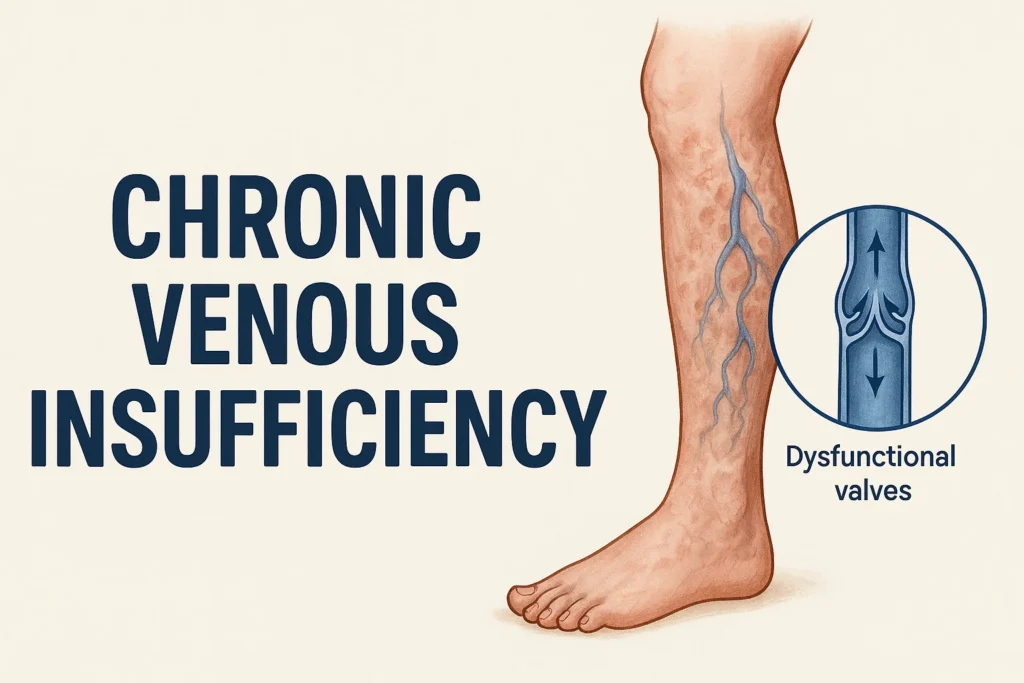Chronic venous insufficiency (CVI) is a common yet often misunderstood vascular disorder that can impact quality of life if left unaddressed. With millions affected worldwide, understanding CVI is important for timely intervention and long-term leg health.

What is Chronic Venous Insufficiency?
Chronic venous insufficiency occurs when veins in the legs are unable to efficiently return blood to the heart. Normally, one-way valves in the veins help guide blood upward, overcoming gravity. In CVI, these valves become damaged or weakened, causing blood to pool in the lower legs—a process called venous stasis.
If blood does not flow freely upwards, increased pressure develops in the veins. This pressure, over time, leads to symptoms ranging from mild discomfort to severe skin changes and ulcers.
Causes and Risk Factors
The most common causes and risk factors for CVI include:
- A history of deep vein thrombosis (DVT)
- Varicose veins
- Sedentary lifestyle
- Obesity
- Family history of vein problems
- Pregnancy (especially multiple pregnancies)
- Older age
- Female gender
In some cases, prior leg injuries or surgeries may damage valves and lead to CVI.
Symptoms of Chronic Venous Insufficiency
Symptoms can develop slowly and may include:
- Swelling in the lower legs or ankles (especially after standing)
- Aching, heaviness, or fatigue in the legs
- Varicose veins (enlarged, twisted veins)
- Itchy or tight-feeling skin
- Skin discoloration (often darkening near the ankles)
- Thickened or hardened skin
- Leg ulcers, particularly around the ankles, in severe cases
Diagnosis
Diagnosis starts with a physical exam and detailed history. Specialists may assess leg swelling, skin tone, and visible veins. Common diagnostic tools include:
- Duplex ultrasound: The primary test to evaluate blood flow and check for blockages or valve malfunction.
- Venography (occasionally): X-ray imaging with contrast dye to map veins.
Treatment Options
Effective CVI management focuses on improving blood flow and relieving symptoms. Treatment options may involve:
Lifestyle Changes
- Regular exercise (walking, cycling)
- Weight management
- Elevating legs
- Avoiding long periods of standing or sitting
Medical Therapies
- Compression stockings: Special elastic garments that help prevent blood pooling.
- Medications: Sometimes, drugs that improve vein tone or reduce swelling.
Surgical and Minimally Invasive Procedures
- Sclerotherapy: Injection of a solution to close abnormal veins.
- Laser or radiofrequency ablation: Minimally invasive techniques to seal off faulty veins.
- Vein stripping or ligation: Surgical removal of severely damaged veins (less common today).
Prevention and Self-Care
While not all cases can be prevented, these strategies help reduce risk and slow progression:
- Stay physically active each day.
- Maintain a healthy weight.
- Avoid prolonged standing or sitting.
- Elevate legs regularly above heart level.
- Wear compression stockings if advised by a healthcare provider.
Frequently Asked Questions (FAQ)
Q1: Can chronic venous insufficiency be cured?
A: CVI cannot be permanently cured, but symptoms can be well managed through lifestyle changes, compression therapy, and, in some cases, procedures that close or remove damaged veins.
Q2: Are compression stockings always necessary?
A: They are a frontline non-invasive treatment. They help reduce swelling, discomfort, and prevent further complications, especially when combined with physical activity.
Q3: What complications can occur if CVI is untreated?
A: Untreated CVI can lead to skin changes, infections, venous ulcers, and persistent pain or mobility issues.
Q4: Are there any activities people with CVI should avoid?
A: Prolonged standing or sitting should be minimized. High-impact sports may not be suitable for everyone; it’s best to consult a healthcare professional for personalized advice.
Q5: When should I see a doctor about leg symptoms?
A: If you experience persistent leg swelling, pain, skin discoloration, or non-healing sores, consult a physician for evaluation.
Key Takeaways
Chronic venous insufficiency is a manageable condition that benefits greatly from early recognition and proactive care. With the right approach—including medical guidance, lifestyle changes, and ongoing self-care—most people with CVI can lead active, comfortable lives.
References:
Cleveland Clinic – Chronic Venous Insufficiency
Wikipedia – Chronic Venous Insufficiency

